The Entrance Moments In Time
Dunleith Guesthouse
Located in Hutton Road North Entrance, where Dunleith Tourist Park stands today. Built in 1890 by Walter and Edith (nee Hargraves) Denniss it was the first guesthouse to operate in the district.
Guests were transported from Tuggerah Railway Station in Dunleith’s sailing boat, the Muriel. In 1903 Muriel was replaced by a modern motorised launch the Ada, which was the first of its type to operate on Tuggerah Lakes.
Dunleith continued to grow with bachelor and married quarters added to the already succesful guesthouse. With the addition of bungalows, Dunleith became even more appealing to tourists.
In 1958 the Littlefield family bought the property and have successfully developed Dunleith into the popular tourist park it is today.
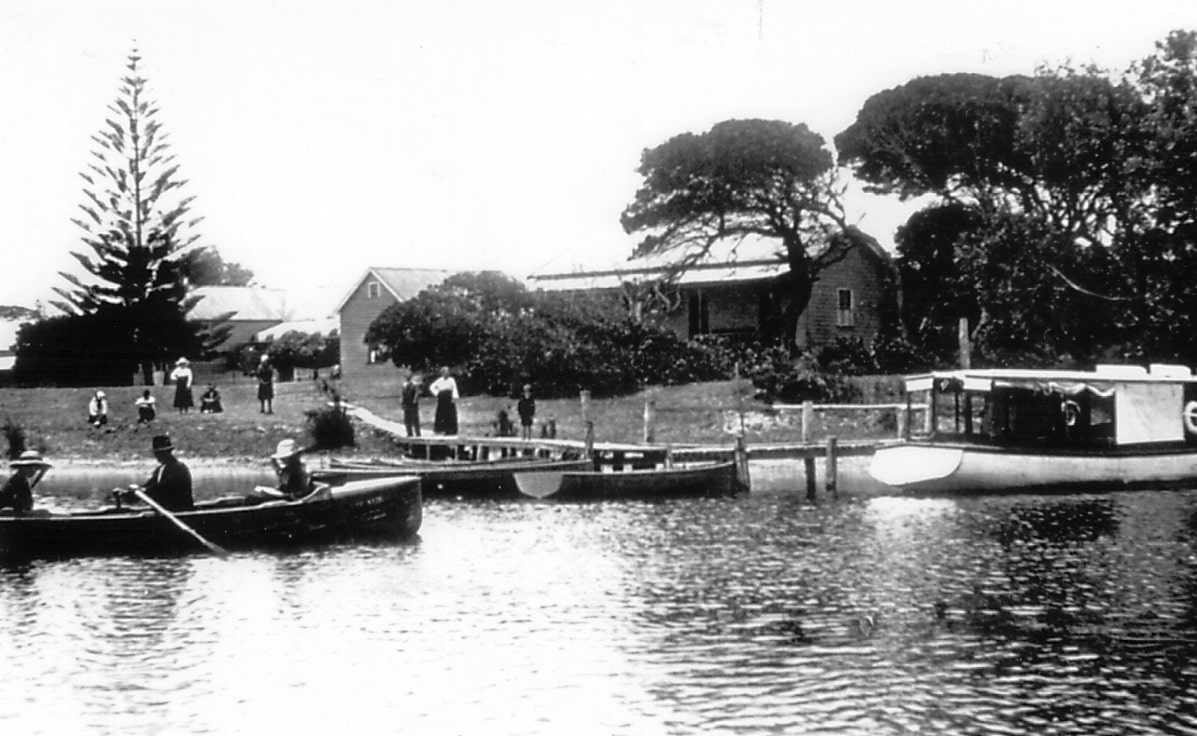
Dunleith Wharf
Pictured on the left is Jack Gleeson, a former owner of Elsiemere Guesthouse at Long Jetty.
He is the father of Mrs Violet Littlefield, who with her husband George and family bought Dunleith Guesthouse in 1958, which the family still own and is now Dunleith Tourist Park.
Please note that at the time of this photograph there were no houses as yet on the Southern side of The Entrance channel.
Also on the left hand side there are two dressing sheds and toilets which were washed away during the early floods.

Bayview Guesthouse
Located on the corner of The Entrance Rd and Ocean Parade, Bayview Guesthouse was built in 1900 by Henry and Adella Dening (daughter of Richard and Gertrude Taylor).
At its peak Bayview could accommodate 150 guests. Bayview also provided accommodation for another 200 people in comfortable furnished tents for those who prefer outdoor sleeping.
In 1938 Jack Ambler purchased Bayview, and in the late 1950’s relocated Tuggerah House to the site and combined both buildings into one. The combination guesthouses fell into disrepair and the property was eventually sold to developers.
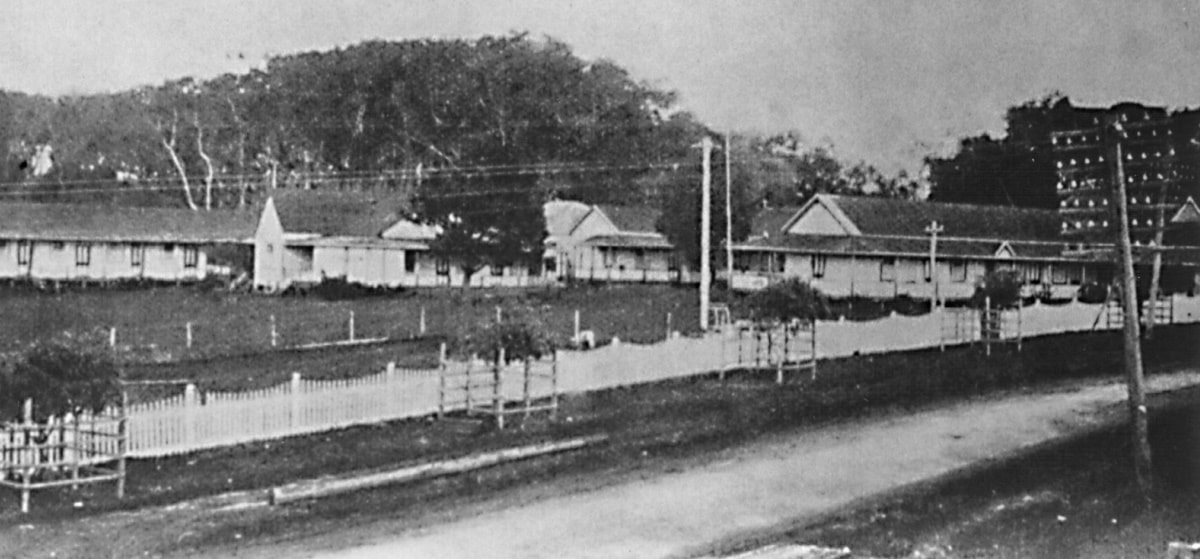
The Channel As It Was In 1904
Dressed for a walk on the beach.
It can be noted that the women shown in the picture wore long dresses and the men dressed in long trousers when at the beach.
This 1904 view shows the channel in its unspoiled state, long before improvements of many kinds were effected.
Those pictured left to right: Fisheries inspector Mr C Gordon, Pioneer Mr R B Taylor, Mrs Adella Dening and three of her sisters. The little girl is Tas Dening.
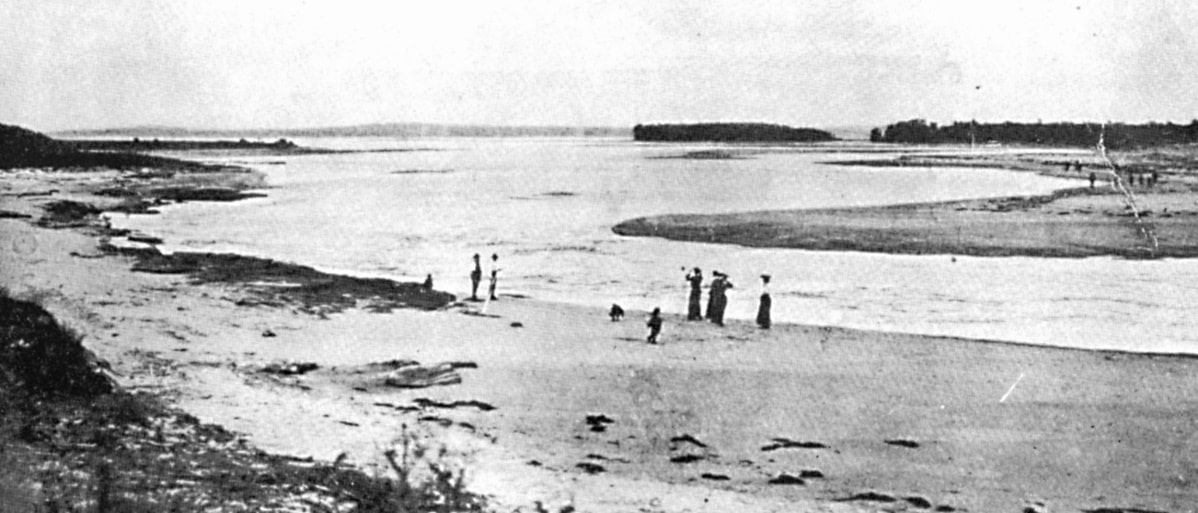
Cabeethon Guesthouse
Located on the border of Hutton Road, Hargraves Street and the channel, The Entrance North.
Built in circa early 1900’s by Walter and Edith Denniss.
No records have been found as to the exact date when it was built, but many old timers remember the guesthouse well.
Sadly Cabeethon was destroyed by fire in 1967.
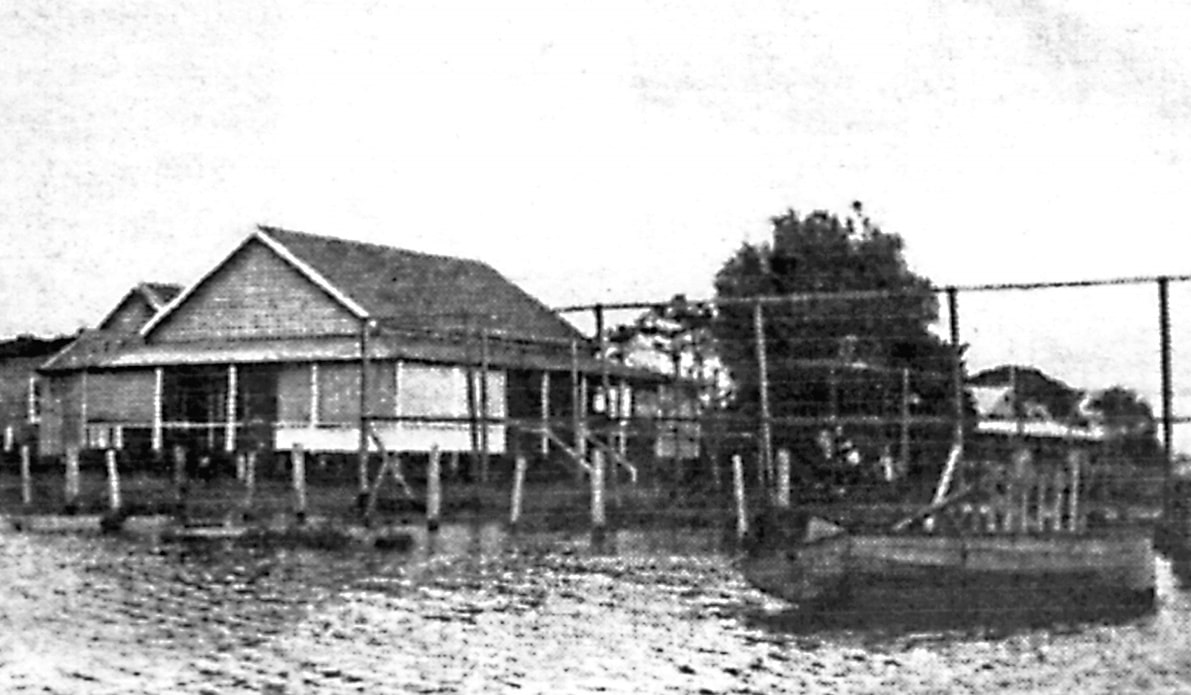
Pinehurst
Built in 1903 by Albert (Les) Taylor, the son of Richard and Gertrude Taylor at 11 – 27 The Entrance Rd. Comprising of a large central residence with outdoor bedrooms and large self contained family rooms. The Taylor’s operated their own launch , the Pinehurst, which provided transport to the guesthouse and for picnics and fishing trips. In 1917 Dick and florence Bateman leased Pinehurst, later they purchased the property.
Widely renowned, Pinehurst became famous as the hub of entertainment. Many lasting romances began at Pinehurst and it was a poular venue for countless honeymoons.
The guesthouse remained with the Bateman family until it was sold to Keith Kelly in the mid 1970’s and it then became Pinehurst Caravillas. The only section of the original Pinehurst Guesthouse that remains today is the 2 storey building on the corner, which is now a restaurant. The building is heritage listed.
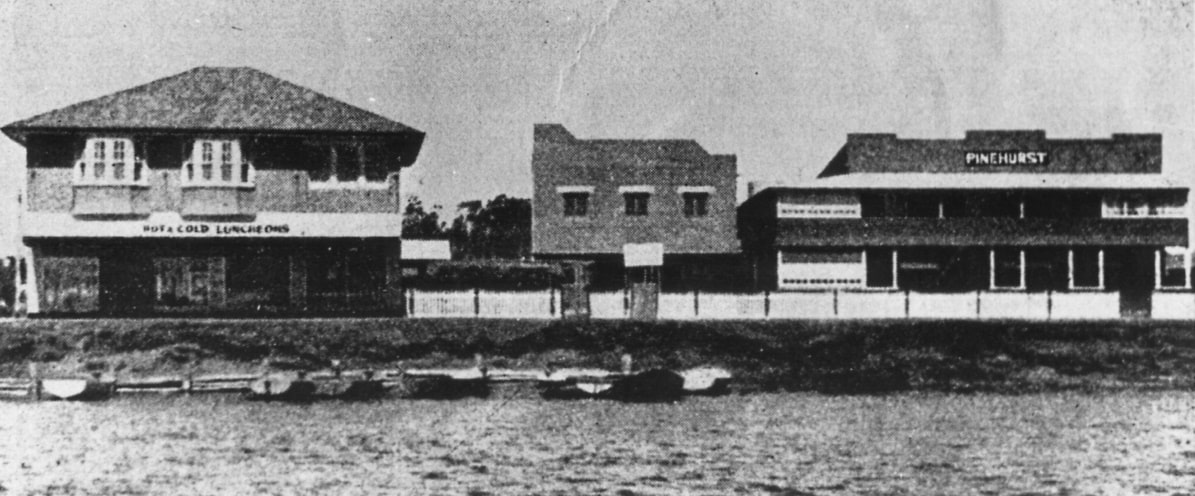
Duffy’s Emporium
Located on The Entrance Memorial Park.
Charles Duffy established his first store in The Entrance in 1906, however he established Duffy’s Emporium in 1910.
The Emporium was built by permissive occupancy with the rear portion of the shop being built on high piers over the shallows of the lake.
Charles was the first established real estate agent in The Entrance. He had his own bullock team which allowed him to cart timber from his property at Berkeley Vale to the Emporium. The largest quantity of any item they stocked were tent poles, and they had between 6,000 and 10,000 at any given time.
On Charles death in 1936, the Emporium was forced to close due to the nature of the lease.
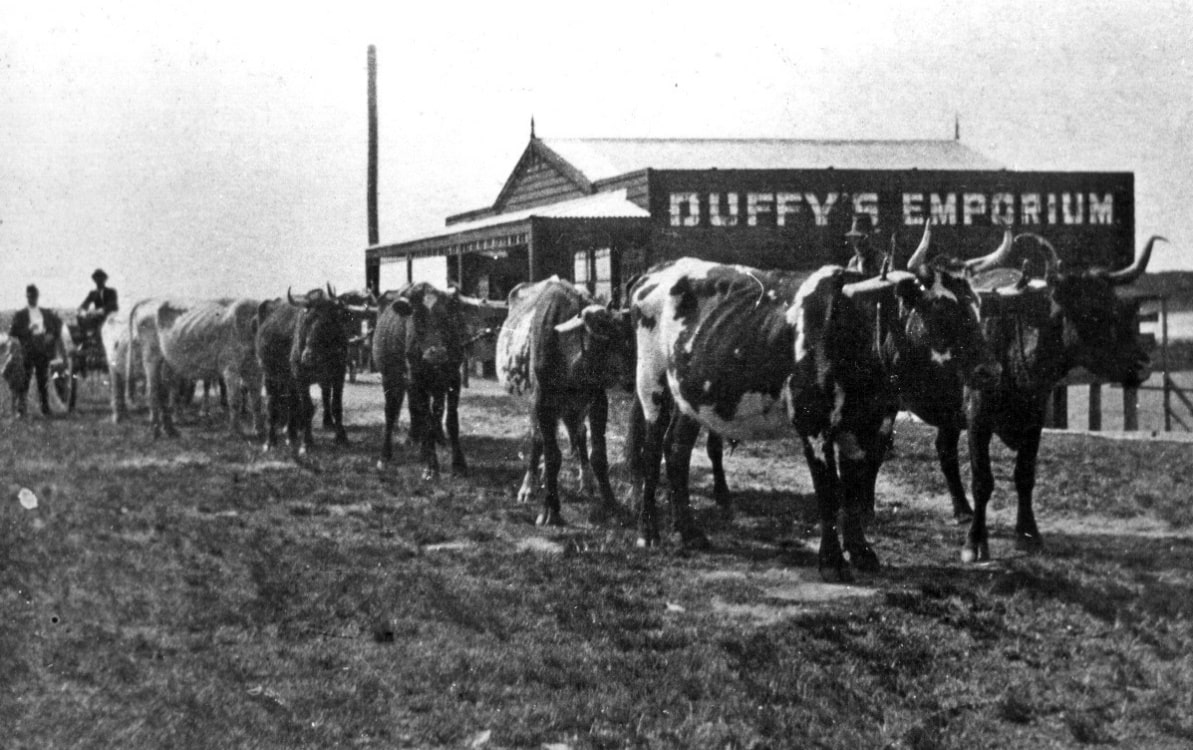
Karagi Point
Located where The Entrance Memorial Park now is.
This photo was taken in 1910.
It shows no houses on the South Eastern side of the channel.
Note the campers tents in the background.

Looking North From The Entrance 1910
Location was the headland at The Entrance, overlooking the channel.
The picture was taken from approximately the corner of Dening Street and Fairport Avenue.
There was at this time a few private homes and four guesthouses in the area.
Terilbah / Rabbit Island and The Entrance North can be seen in the background.
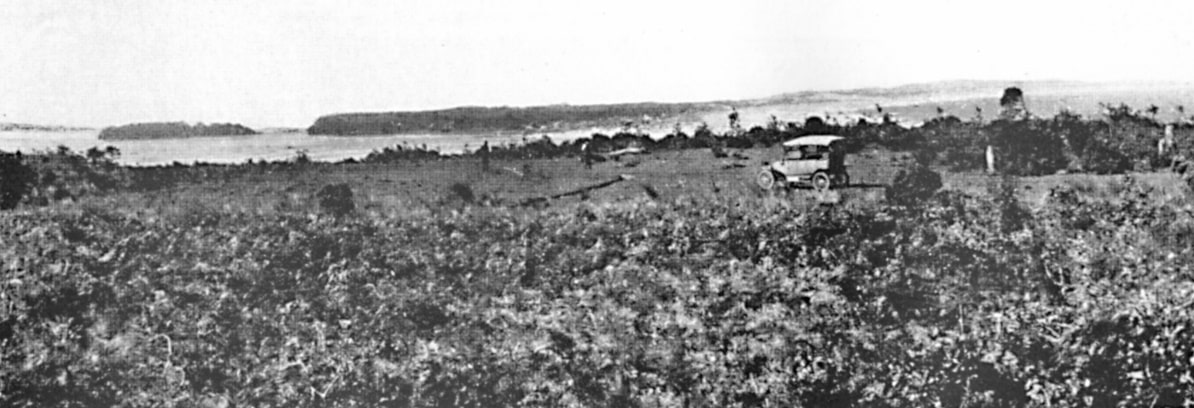
The Entrance Dairy
About 1916 Raymond Clyde Taylor established a dairy at The Entrance on a 53 acre property he had aquired from his father.
In the holiday season he sold the milk locally to the guesthouses in bulk for fifteen pence a gallon.
He also sold it in smaller quantities to campers in tents and households for five pence a quart.

Tent City
This photograph shows an array of tents along The Entrance channel in the early 1920’s.
The location is the current board walk at Memorial Park.

The Entrance Boathouse
Built circa 1920 by Austin, Louis and Irving Taylor (sons of Richard and Gertrude Taylor) along with Robert Duncan Brownlee.
The timber for the boatshed was carted from the Brownlee sawmill at Ourimbah. The business was known as Taylor Bros. and Brownlee Boatshed. It basically built, repaired and rented out rowing boats and launches.
Robert Duncan Brownlee operated the boatshed and his young son Robert William’s spare time was spent painting and assisting in building the boats. Robert Duncan Brownlee’s partnership with the Taylor brothers lasted until his death on the 27th of October 1935.
The boatshed is now known as The Entrance Boathouse and there have been claims that it is the longest running boatshed on the East coast of Australia.
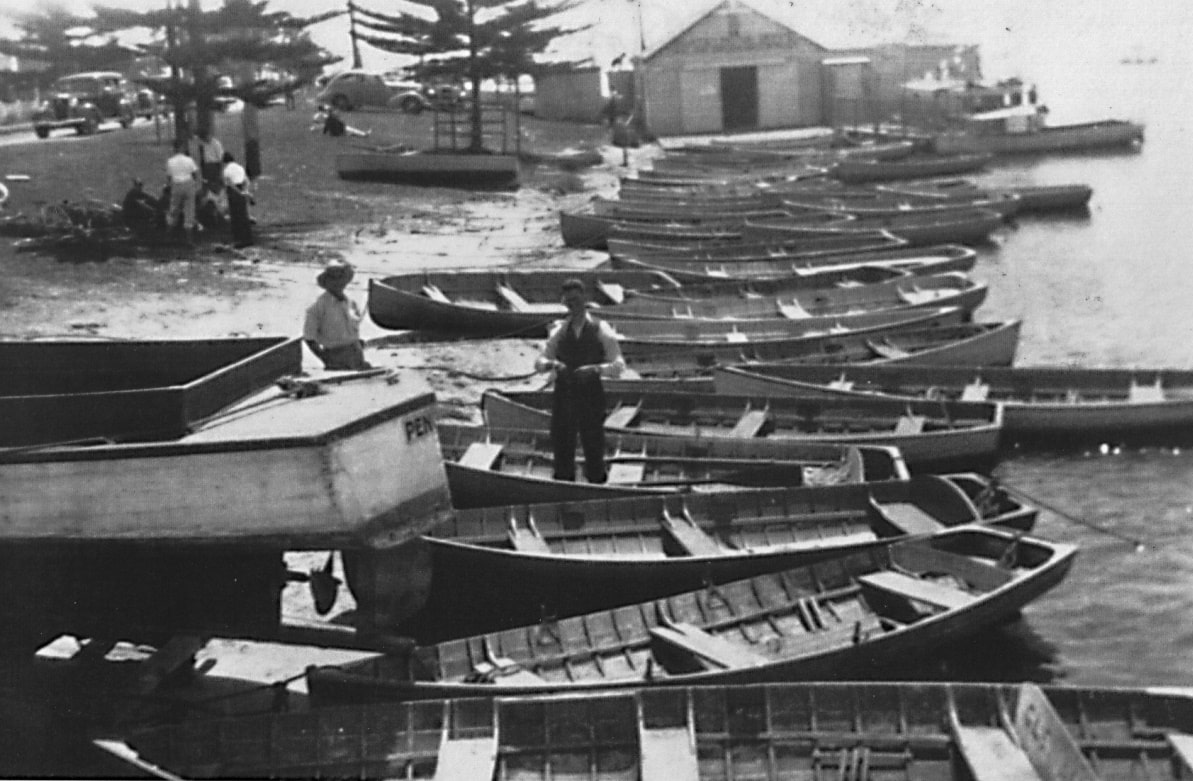
Off To The Beach
Bathing Belle’s photographed ready to go to the beach.
They are wearing the typical swimwear, including umbrellas, which were indicative of the era.
Photos taken circa 1920.

The Entrance Brickworks
Located on the corner of Taylor and Warrigal Streets, The Entrance Brickworks was established by the children of Richard and Gertrude Taylor, Austin and Les together with their sister Adella Dening in the 1920’s. They appointed Mr Staunton as manager. A very small plaster works was located on the same site.
The sandstock bricks for the first Catholic Church were manufactured at the brickworks. Only 2 buildings are still standing in The Entrance that were built from these unique bricks. Those buildings are Austin and May Taylor’s home and The Entrance Hotel.
The photograph was taken on the 14th of May 1920 and shows a group of citizens celebrating the first batch of bricks to come from the kiln. The brickworks life was short lived and closed after only 3 years of operation.
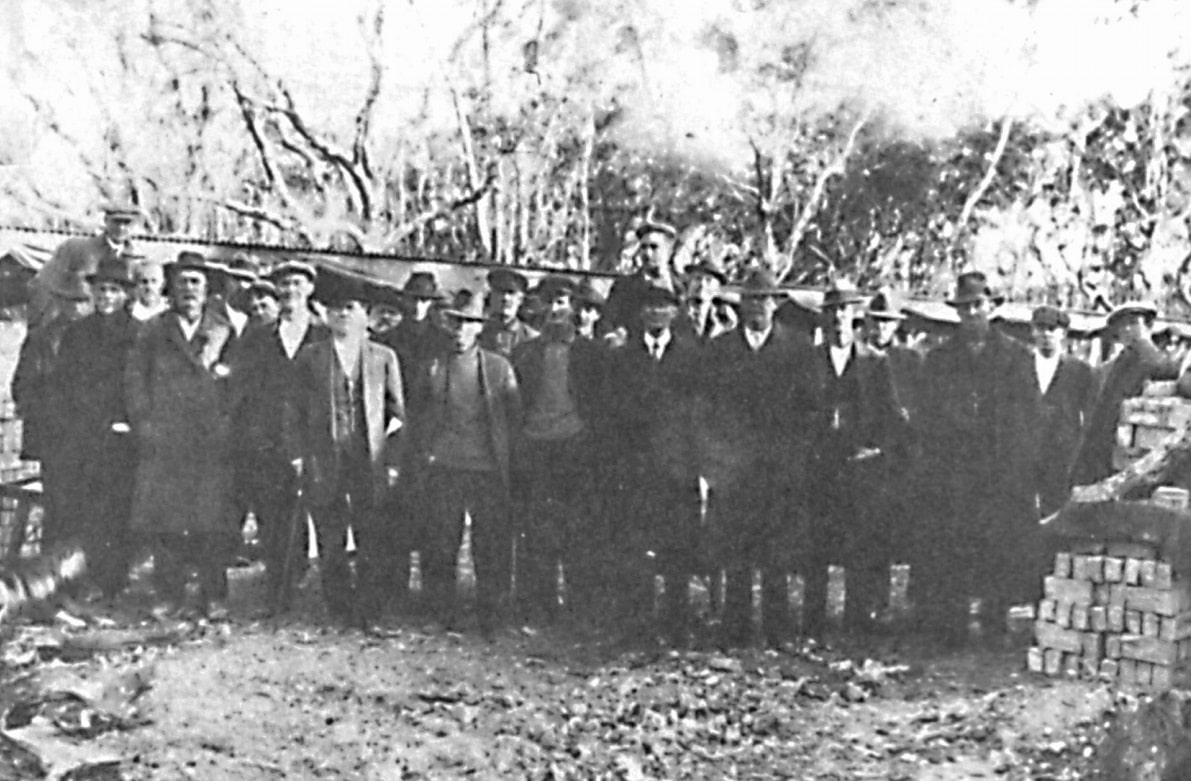
Lorna Doone Boarding House
Located on the corner of The Entrance Road and Dening Street, Lorna Doone was built, owned and operated by Alfred and Ethel (nee Denniss) Watkins.
The first Taylor subdivision took place in 1921 and it was soon there after that Lorna Doone became the first boarding house built in that subdivision. It was named after the Watkin’s daughter Lorna.
The boarding house will be remembered well for the dances that were held on the beautiful wide verandahs, garden parties and fetes.
Alfred Watkins was a Wyong Shire Councillor from 1947 to 1950. On the 29th of April 1979, this tourist icon was demolished to make way for the Lakeside Shopping Centre.
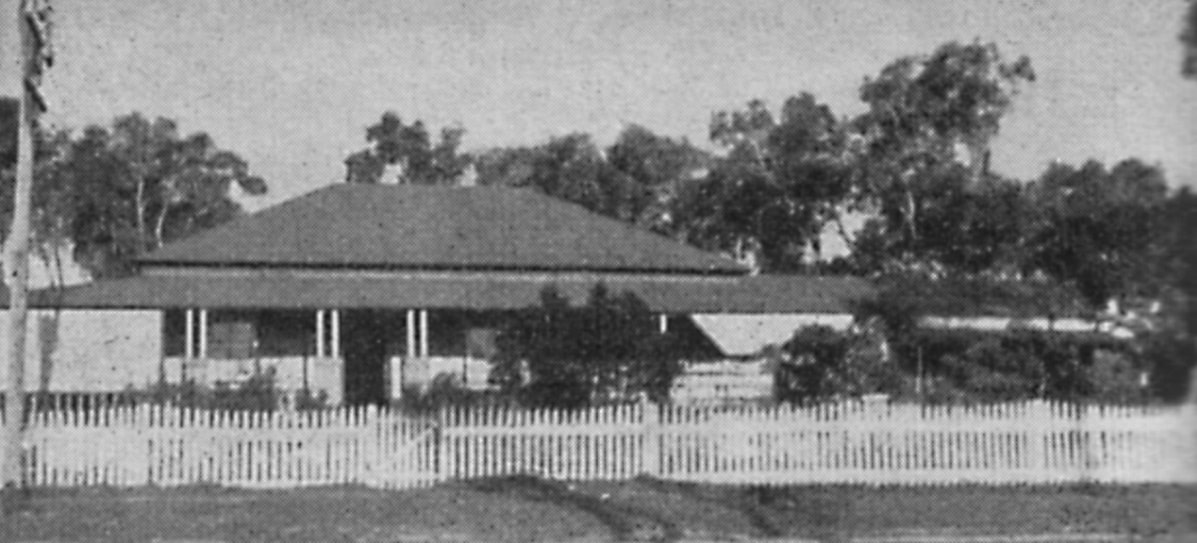
The Home Of Austin And May Taylor
Located at 113 The Entrance Rd, in front of the waterfront plaza, and built in 1922 by Austin Taylor (son of Richard and Gertrude Taylor).
It is one of the oldest existing buildings in The Entrance and one of the last of the Taylor homes. This home, and The Entrance Hotel, are the only 2 buildings left standing in The Entrance that were built from bricks made at The Entrence Brickworks kiln.
Austin Taylor was an astute businessman and well known sportsman. He was involved in the early Wyong to The Entrance ferry services and later branched out into motorised bus transport.

Lakeside Gusethouse
Located at 29 The Entrance Rd, The Entrance.
Built in 1923 by Laura (Rene) Nicol, daughter of Richard and Gertrude Taylor. Lakeside Guesthouse was the most modern of all the guesthouses built in The Entrance at that time. It boasted electric light and was beautifully furnished throughout with oak panels.
In 1945 Jim and Rita Nicol purchased the property from Jim’s mother. It had an outstanding reputation for it’s wonderful cuisine. The Nicol’s also offered clean, comfortable furnished cottages in addition to a well appointed caravan park.
On the 4th of March 1989, the property was sold to Geno Corporation for $1.4 million. After the sale, the guesthouse building was moved to a rural location at Gwandalan.

The First Bank Building
Located at 115 The Entrance Road, The Entrance.
The original bank consisted of two rooms and was constructed of timber and fibro and was located on the corner of Coral street and The Entrance Road.
Originally the bank was open for business just one day per week, however after a short time it became necessary to open 3 days per week. Bank staff travelled from the Wyong branch by ferry to man The Entrance office. The Wyong Bank manager at that time was Mr “Tiny” Edwards.
As business increased a more substantial building became necessary, so a purpose built bank was constructed by local builders, George and Clarence Smith, for and on land owned by Austin Taylor in 1923. It was leased to the Commercial Bank Of Australia, Wyong.
On its completion, the Commercial Bank Of Australia opened it’s doors at 115 The Entrance Road. The bank remained at that location until the amalgamation of the banks occurred, it was then moved to the corner of Dening Street and The Entrance Road.

Allambee Guest House
Located on the corner of The Entrance Rd and Ocean Parade, (currently KFC).
Built by Adella (daughter of Richard and Gertrude Taylor) and Henry Dening, they took up residence at Allambee in 1923. It was a grand home, boasting a circular driveway, rose gardens and beautiful verandahs, which took advantage of the sweeping views from all sides.
On Sundays, Father McMahon travelled from Wyong by ferry to celebrate mass in the Allambee dining room. Mrs Dening taught catechism to the local children to prepare them for the sacrement. Mass was held at Allambee from 1923 to 1925. During holiday times, Allambee had difficulty in coping with the increased number of worshipers due to the tourists who visited the area.

Camping On The Headland
Camping on the headland at The Entrance.
Tents are shown here on the headland overlooking the channel in 1923.
This was a very popular area for visitors wishing to camp.
In the background is Terilbah / Rabbit Island and The Entrance North.
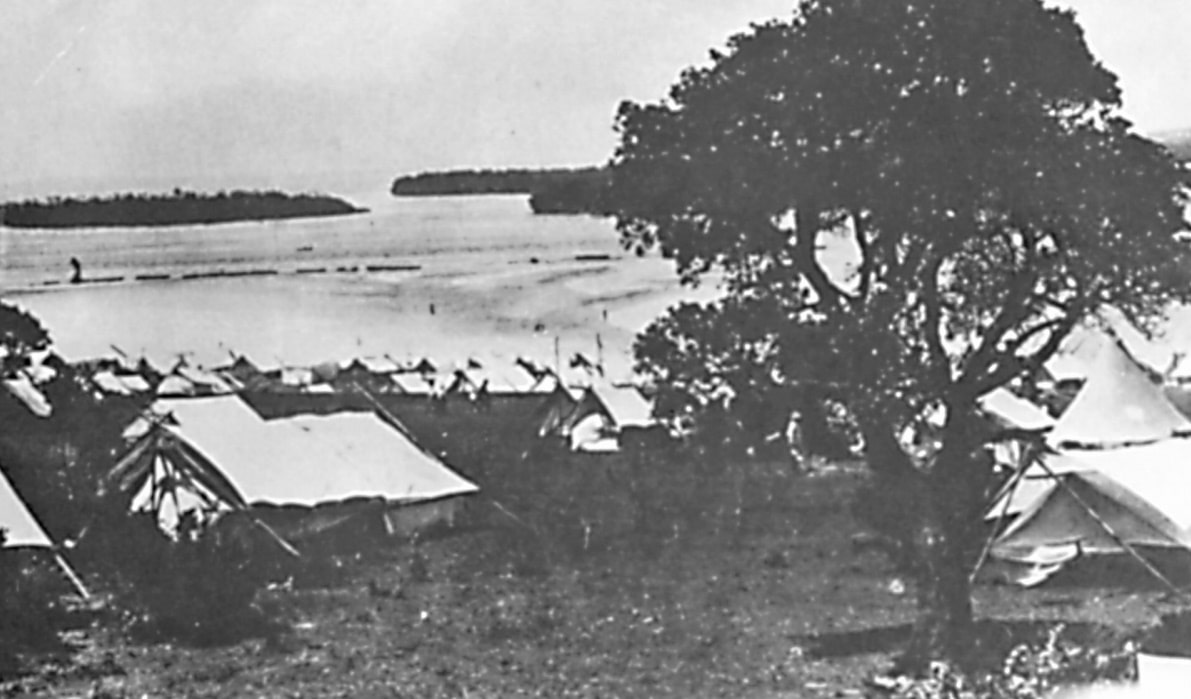
Pinetrees On The Entrance Channel
This photograph was taken circa 1923.
Shown in the background is Duffy’s Emporium which was built in 1910 by Charles James Duffy.
To the right is the Wintergarden Theatre (licensed as The Entrance Picture and Dancing Palace) built by Vincent George Taylor and opened in 1920.

Early Police Officers
Left – Constable Jack Kempton
Right – Constable Bill McCormick
Constable Kempton took up his posting at The Entrance in 1924. His first transport for patrol was a push bike.
Many old timers affectionately remember Jack / Kempy as a gentleman and excellent Police Officer. He was highly respected by the community.
The first Police Station established in 1926 was a simple shed attached to Taylor’s Ferry Wharf, however, the wharf suffered repeated flooding. So the second, and temporary station, was set up next door to the Wintergarden Theatre.
In 1931 another Police Station was erected, on the site where the Lakes Hotel is today. This was during the depression years and people were required to queue up to collect their dole payments from this small office. In 1944 Seargent Jack Kempton was transferred to Newcastle.
The fourth Police Station was established in a house on the corner of Short Street and Dening Street (now a car park). The fifth could be found at Vincent “Vinty” Taylors home on the corner of Ozone Street and Ocean Parade.
In 1947 Constable Bill McCormick took up his duties in The Entrance and in 1948 a sixth Police Station was established on the current site in Denning Street.
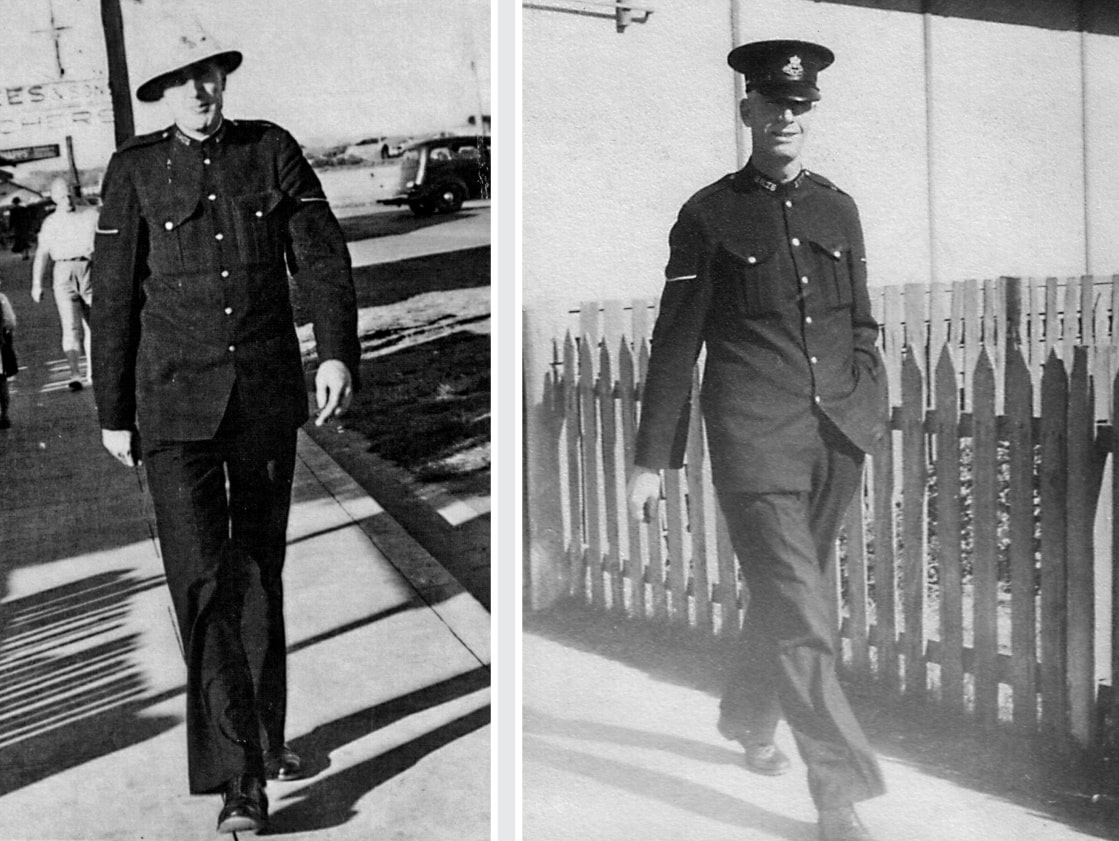
The Elms Guesthouse
Formally Entrance House / Oceanic / Oceana Guesthouse, the Elm’s guesthouse was built in 1926 by Richard Taylor for his daughter Edith. Located in one of the most scenic positions on the hill, overlooking the channel and looking back toward Terilbah Island.
Pictured in the foreground is the American Tea House, which was later relocated to the side of the guesthouse and converted into one bedroom units.
After numerous leasees, it was run in 1956 by Neville and Noleen Corrigan. The Corrigan’s eventually purchased two thirds of the property freehold from Richard (Dick) Taylor who was a real estate agent and acting on behalf of his family, who were still the original owners of the guesthouse. In 1972 the Corrigan’s sold The Elms to supermarket giant Jim Flemming, the head of Flemings Food Stores.

Cenotaph
Located on the corner of The Entrance Road and Marine Parade.
In 1914 when World War 1 began, the population of The Entrance was 58. The first ANZAC Day reunion was held on the 26th of April 1926 at Duffy’s Emporium. On that day it was unanimously agreed to apply to the Lands Department for a small proportion of land on the lake shore to be used for the erection of a war memorial. After permission was granted for the project, a German field gun which had been promised to the Sydney suburb of Willoughby, was obtained. After a delegation from Willoughby demanded the return of the gun, it was decided to place a 24 hour guard on the gun for safe keeping. It was decided that The Entrance could keep the gun and the matter was closed.
The War Memorial was opened on the 6th of November 1926 by Governor Sir Dudley De Chair. During the unfurling, Sir Dudley inadvertently became entangled in the 6m x 3m flag that had covered the gun during the ceremony. In 1930 the Memorial was reconstructed into the shape of a hexagon and a new 72 foot high flagpole was put in place. On the 10th of November 1960 a large gathering witnessed the dedication and opening of the new Garden Of Rememberence and Memorial Fountain, an initiative of The Entrance / Long Jetty RSL.
In 1996 the main street and foreshore area of Memorial Park underwent a massive facelift and as a result the cenotaph has become a major focal point for those visiting the area.

Stewart’s Store
Located on the corner of The Entrance Road and Dening Street.
The shop was built on the first Taylor Estate subdivisions in 1927. It was built as a general store by the owners of Lorna Doone Guesthouse, Alfred and Ethel Watkins.
They were the first operators and it was known as Watkins General Store. When it was taken over by the Stewart family, it became Stewart’s Store.
It became a well known landmark for the campers who visited the area in the early times and during World War II. It then became William’s General Store, then Garth Busby’s furniture store, and it is now part of Lakeside Plaza.

Tuggerah Lakes Golf Club
Henry (Todd) Shaw came to the area in 1927. He purchased approximately 170 acres of land at Killarney Vale where he built his stately residence.
He laid down a 9 hole golf course, and transformed his home into the Club House, on the understanding that when the Club was financially able, they would purchase the property. The official opening took place on the 5th of October 1929.
The Tuggerah Lakes Golf Club was officially formed on the 1st of September 1930. On the 1st of August 1954 the club transferred to the current location at Shelly Beach, and eventually was renamed Shelly Beach Golf Club.
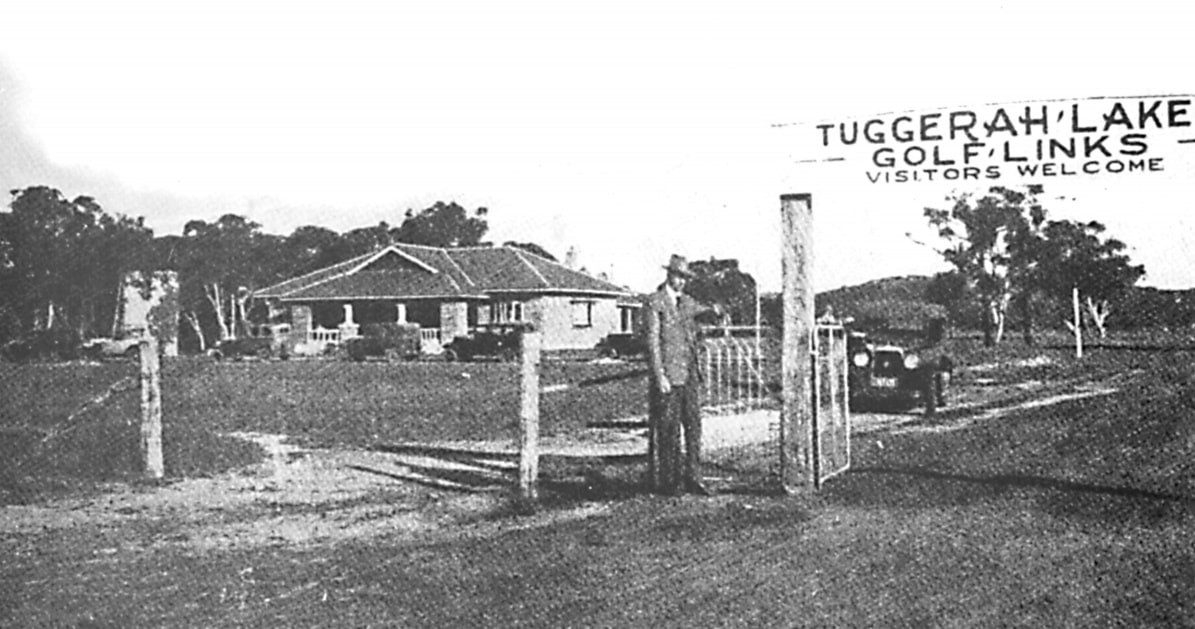
The Entrance Hotel
Located at 87 The Entrance Road.
It was the first hotel in The Entrance and was the tallest building for miles around.
First planned in early 1925, the hotel was built by C. Hayter and Son for Tooths LTD.
It was opened on the 16th of December 1927 and the first licensee was Matt White.
The hotel was badly damaged in November 1934 when the adjoining Wintergarden Theatre was gutted in a spectacular blaze.
The hotel has a heritage listing.
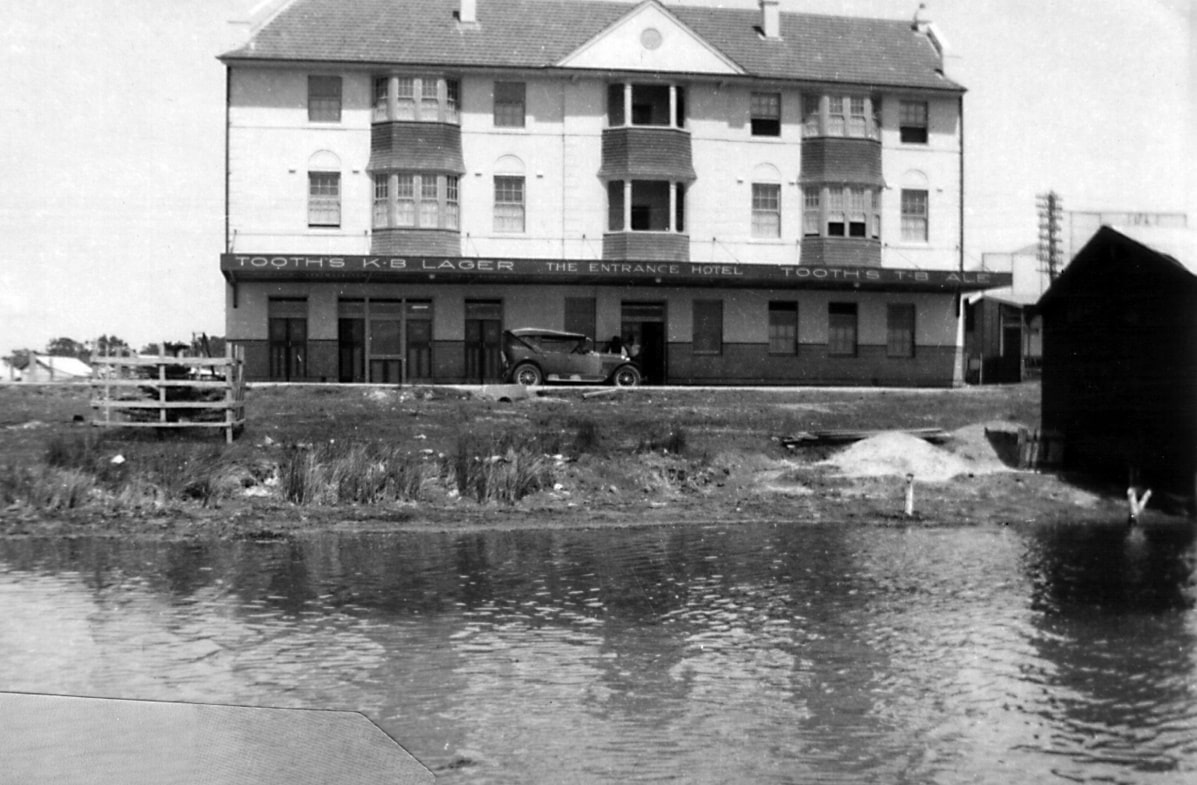
Boat Moorings The Entrance Circa 1930
These are the typical fishing boats that were used on Tuggerah Lakes.
This photograph shows well known fishing expert Harry Dennis’s boat moorings in The Entrance channel, located on the reclamation area now known as Memorial Park.
The large building in the background is the Elms Guesthouse, previously known as Entrance House / Oceanic / Oceana.
Built in 1926 by Richard Brown Taylor for his second child Edith (known as Edie) in one of the most scenic positions in the entire area. It overlooked The Entrance North, the channel and back towards Terilbah Island. On the right, Dening’s holiday cottages can be seen.

The Entrance Cricket Ground
The cricket ground was located in a paddock behind Tuggerah House, now the site of the Ebbtide Mall.
The team shown here is The Entrance Cicket team circa 1932.
Back left to right:
Jack Glover, Harry Denniss, Bill Douglas, Alf Clifford and Tibb Barsley.
Front left to right:
Fred Douglas, Austin Taylor (son of Richard Brown Taylor), Peter Clifford, Frank Plunkett, Alf Watkins and Page Pearce.
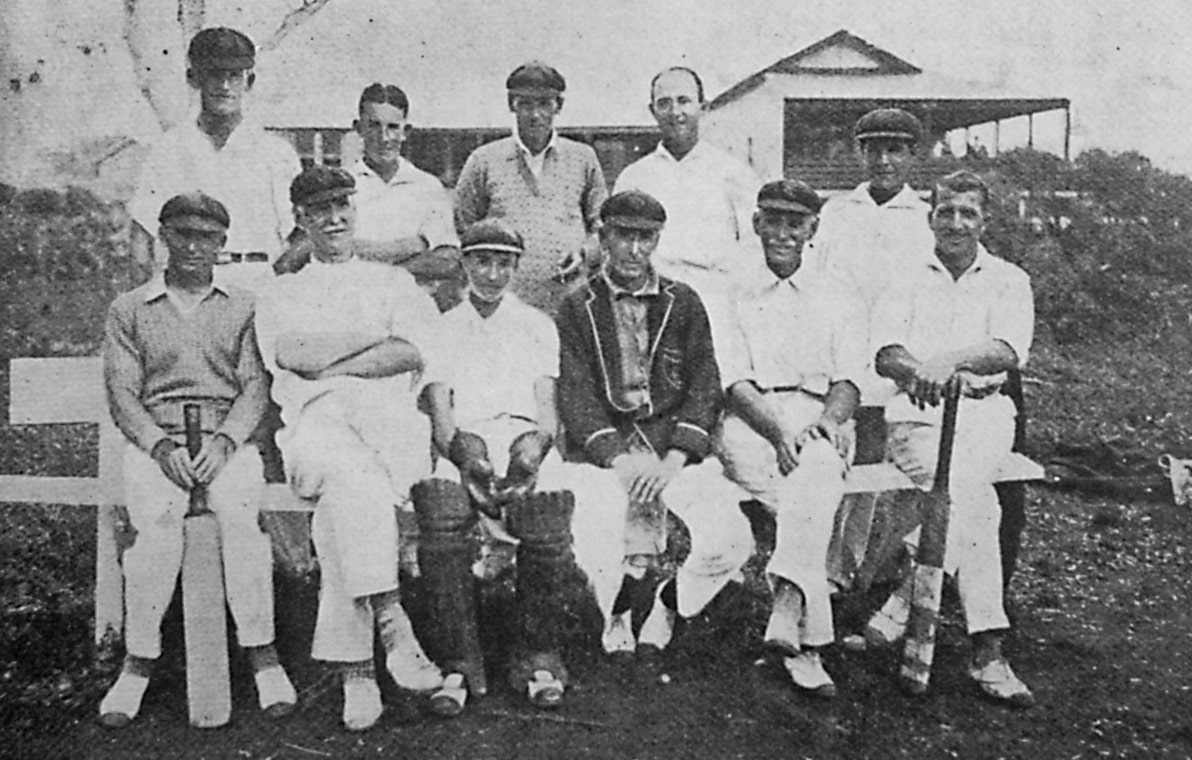
Prince Edward Theatre
Located at 54 The Entrance Rd.
Built by Edward J Brennan the theatre was considered one of the most elaborate outside of the Sydney Area. It was officially opened on the 21st of March 1934.
The Prince Edward featured an outstanding interior which was made up of highly decorated arches and unique friezes. A full house seated 750 people. A major feature of the theatre was the exterior brick fascade.
By September 1976 the Theatre only operated during school holidays. The theatre closed on the 11th of June 1977, however it reopened on the 21st of December 1981.
The building was gutted with only the stairs to cinema 1 and the leadlight on the front doors remaining of the old theatre. The original terrazzo floor is thought to be under the carpet in the foyer. The theatre was capable of seating 380 people and included specialty shops.
In 1988 the theatre was renamed The Entrance Cinema and a theatre was added. It was sold again in 2005.
Tom and Jerry was the final movie screened at The Entrance Cinema when it closed on Sunday the 18th of April 2021.

The Public School Tuckshop
Located just up from the Presbyterian Church on The Entrance Rd.
The tuckshop was first owned by the Fairhall’s, then Mrs Taylor and later Mr and Mrs Garrard.
It supplied lunches, morning teas, sandwiches, pies, cakes, ice blocks, ice creams and confectionery for the school children.

Fishing Frenzy
This early photograph of The Entrance channel shows that fishing has been a huge attraction for The Entrance.
Locals as well as tourists would line the shores every day to catch the many fish swimming by.
The channel was also very popular for prawning.

Fishing Made Easy
The Closure of The Entrance channel has always been a problem.
Today the Council ensures the channel remains open.
This 1939 photo shows the community taking advantage of the huge number of fish that became available on the run out tide.
Most of the people are shown with scoop nets reaping the benefits of easy fishing.
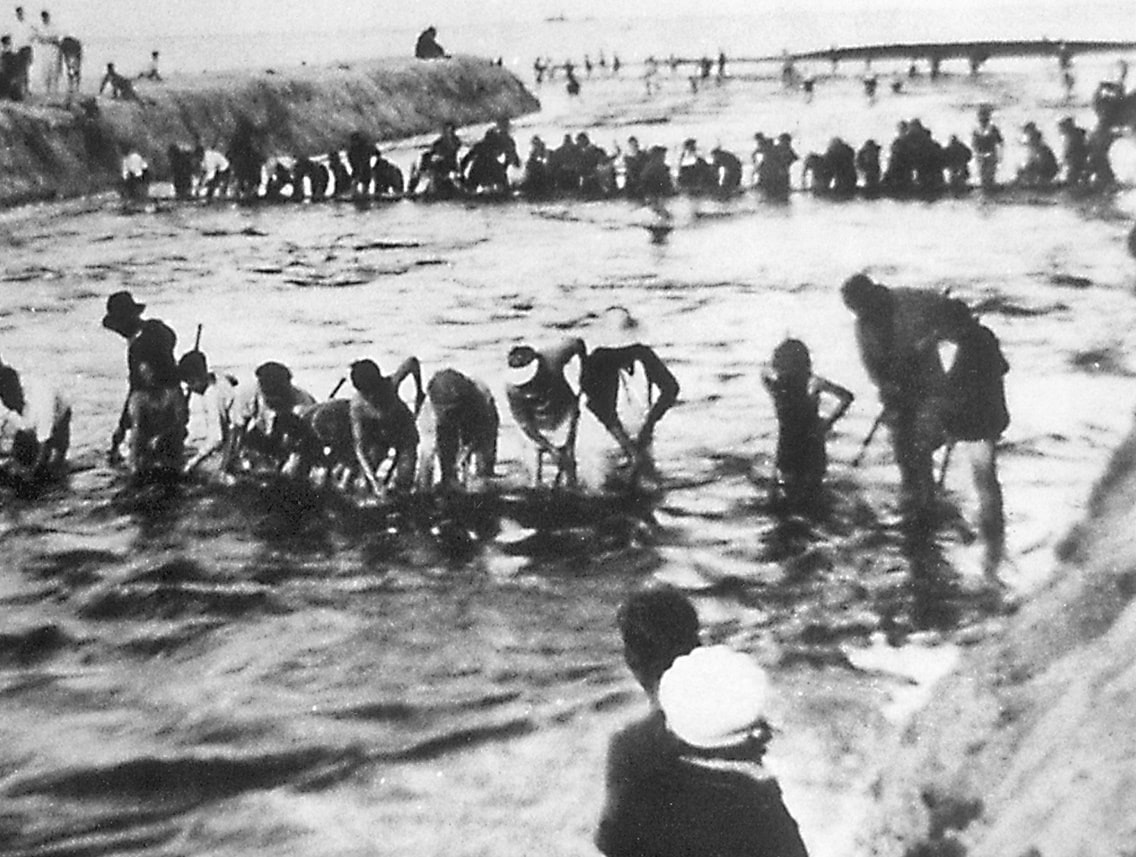
Fishing On Tuggerah Lake
This is a typical fishing boat used by locals on Tuggerah Lakes.
Well known fishing expert Harry Denniss, made his own lobster pots from wild grape vines that grew on The Entrance North peninsula.
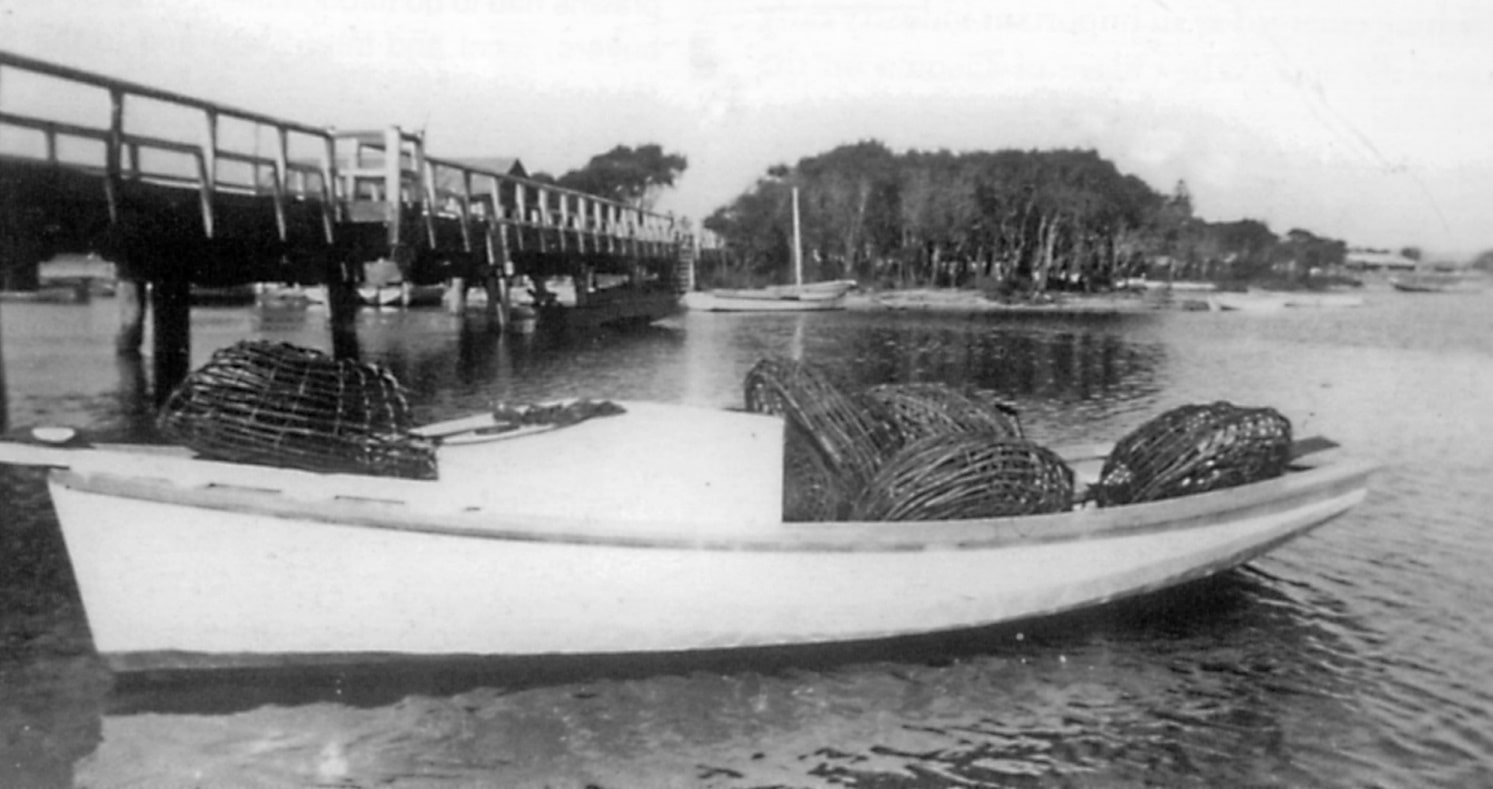
All Saints Anglican Church
Located on The Entrance Rd, opposite The Entrance Public School. The land was donated to the Anglican Church by Richard and Gertrude Taylor.
The Church Of England Mission Hall was dedicated by Dr Stephen, the Bishop of Newcastle, on the 29th of December 1923. It was dedicated as the All Saints Church on the 1st of March 1943 by Francis De Witt Batty, the Bishop of Newcastle. The first priest in charge was Rev John Sherlock who took up his duties on the 1st of February 1947.
The new All Saints Church at 287 The Entrance Rd was dedicated on the 30th of April 1972, and the old church building was moved to a block of land at Tumbi Umbi, which was owned by the Church Of England, and it was renamed St Christopher’s Church.
After the church was closed, the building was moved to Brooke Ave Bateau Bay, where it formed the shell of the new St Christopher’s Anglican Church.

A.H Pearce Chemist
Located next to the Wintergarden Picture Show and opposite the old wooden bridge, now The Entrance bottle shop.
Between 1920 and 1926, Alfred Pearce practised as the first chemist in The Entrance. The shop operated as a general store and dispensary combined, and provided a delivery service to it’s customers.
In 1926 Alfred retired and the shop was taken over by Mr Inglis.
In 1929 Jack Hall established J.C. Hall Post Office Store, which sold an outstanding array of goods.
Mr Hall was known as a genial gentleman, who remained on deck all hours attending to the many residents and visitors of the Tuggerah Lakes area.
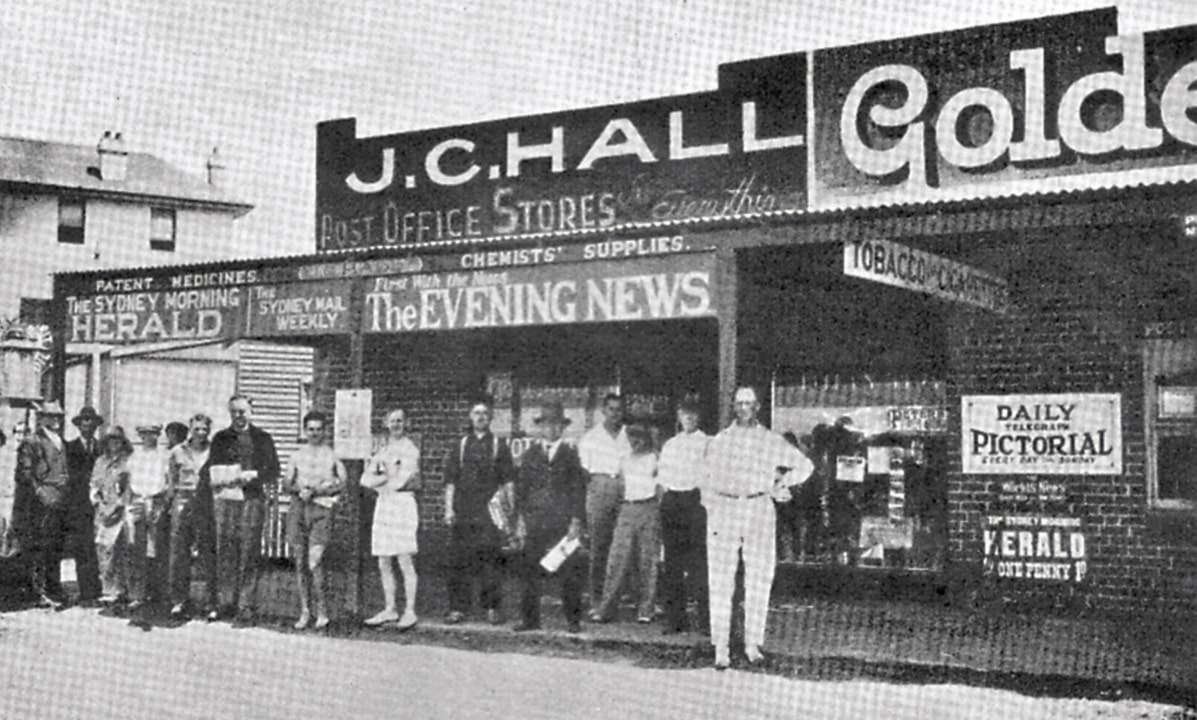
Newlings Bakery
Reginald and Muriel Newling established their third bakery in December 1932 opposite the intersection of The Entrance Road and Dening Street.
They made their first deliveries to customers in a two horse drawn bread cart. All ingredients were mixed by hand, the dough was prepared the previous evening and left to sit for 5 to 6 hours. It was then placed in the wood fuelled ovens to be baked into crisp fresh bread.
During the holiday period, the Newling’s enjoyed a roaring trade as shown in the photo. They continued to operate the business until 1952 when they sold it to Doug Goode, who later sold it to Buttercup Bakeries.

Golden Gate Cafe
Located at 195 The entrance Road, The Entrance.
Built in 1933 by Mr Mantoni after his original cafe, which was located at the bottom end of town, was destroyed in the Wintergarden fire. His first cafe was highly succesful as it generated business from the Wintergarden, residents and tourists going to and from by ferries.
Just prior to the fire, the Prince Edward Theatre opened. After the fire Mr Mantoni, who was an extremely astute businessman, decided to open a new cafe opposite the new Prince Edward Theatre. He succesfully operated the business for some years before he sold it to an unknown American who renamed the cafe the Golden Gate Cafe.
In the 1940’s, Nick and Thea Lourandos purchased the cafe. Then in 1952 a young couple Dennis and Lola Raft joined the Lourandos’s as business partners. In 1955, Lola’s brother Johnny Adilinis purchased the Lourandos’s share and became a partner.
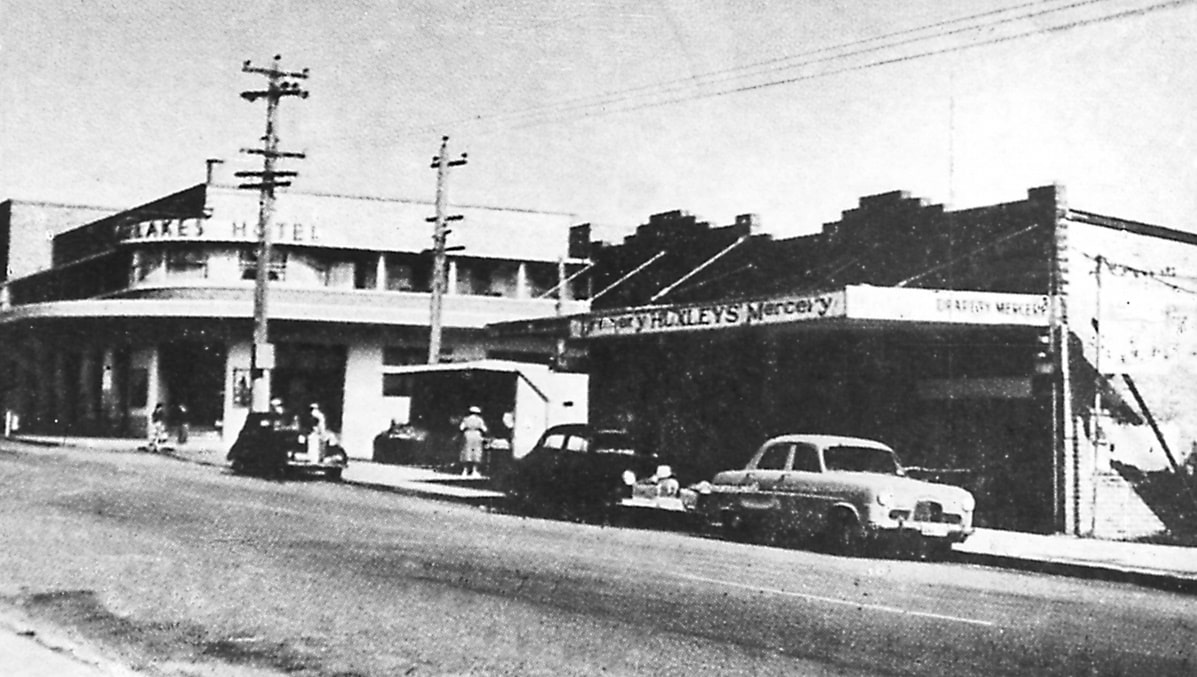
Local Shops
During the 1930’s and 1940’s many small sets of shops were built throughout The Entrance.
This small set of shops were located on The Entrance Road opposite Dening Street.
This photo shows the typical look of the shops.
Seen here is Hamill’s Real Estate, Mrs Wickhams Wool Store, a milk bar and bakery.
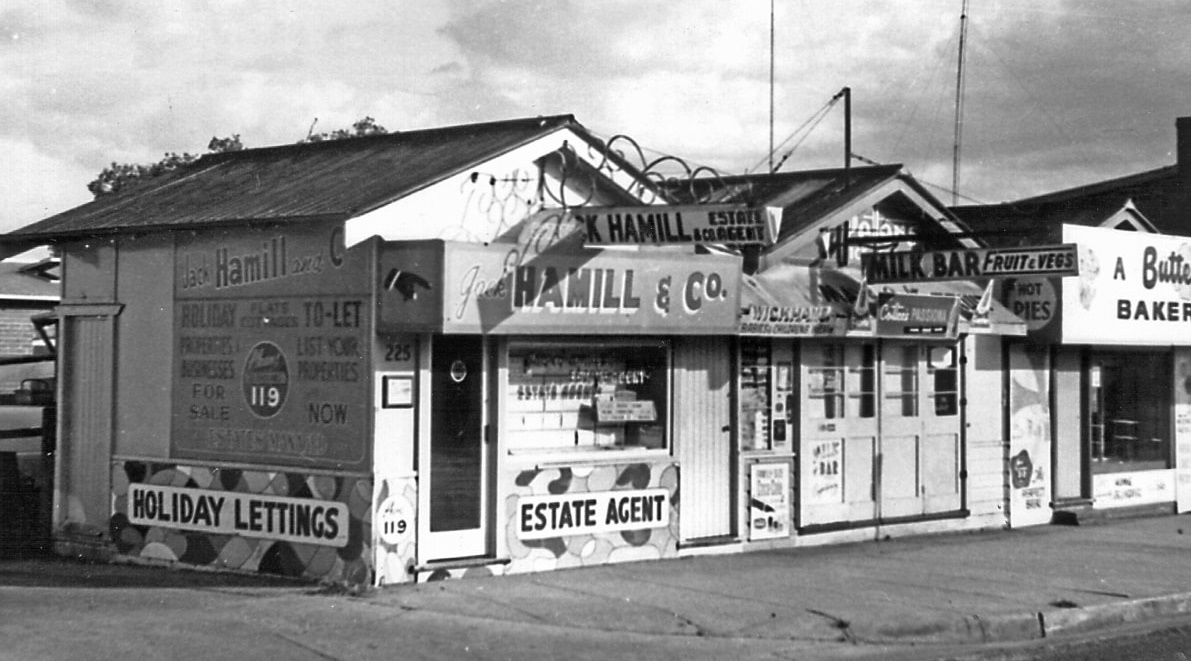
The Entrance Ocean Baths
Over many years the ocean baths have evolved from a simple rock pool, which had been constructed during the Great Depression.
In June 1934 it was mooted that a rock swimming pool would be a fine additional attraction for The Entrance.
It was stated that the baths were likely to be ready for use in the Summer of 1934.
In 2003 the baths were classified by the State Government as a heritage item.

The Entrance Surf Club
The first life saving team was formed at The Entrance in 1922. In the very early 1930’s Erina Shire Council constructed a weatherboard building which soon became known as “The Clubhouse (shown here on the right).
On the left is the current clubhouse which was built with subscriptions, and a Government grant was obtained through Erina Shire Council for a “School Of Arts” building.
On the 2nd of June 1940 the Surf Club held its first meeting in the new clubhouse. The builder of the clubhouse remains a mystery.
The building is now classified by the National Trust as a Heritage building

The Entrance Beach In The 1940’s
In the 1940’s, many visitors came to The Entrance to enjoy the great seaside lifestyle.
In the background you can see the Brownlee home and their rental cottages, which enjoyed uninterupted views of the beach and ocean.
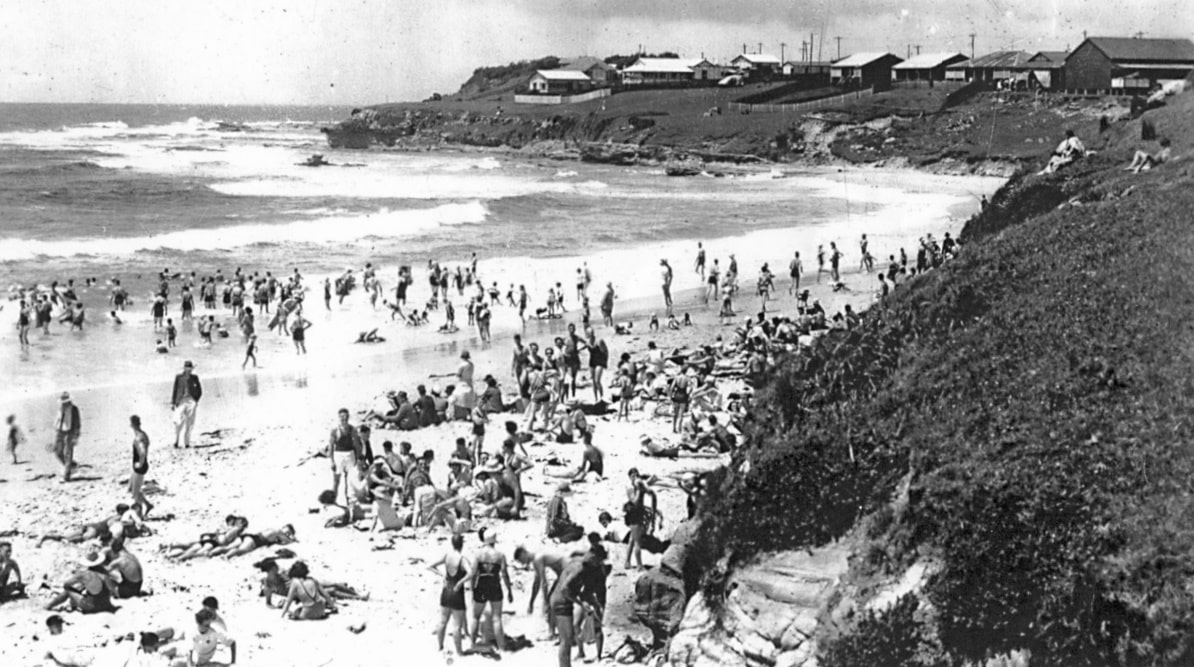
The Lakes Motel
Located at 201 The Entrance Road, the building of the hotel was an interesting decision as there was already a succesful hotel operating in the town. The decision to build was made at the height of World War II, when all building activity was depleted due to lack of building supplies.
It was a major project for a small town but Tooth & Co could see The Entrance was quickly becoming a dominant tourist destination.
The architects were Prevost and Associates and it was built by Hutchersons Brothers and opened on the 6th of November 1941. The first licensee was Emmett P Collins.
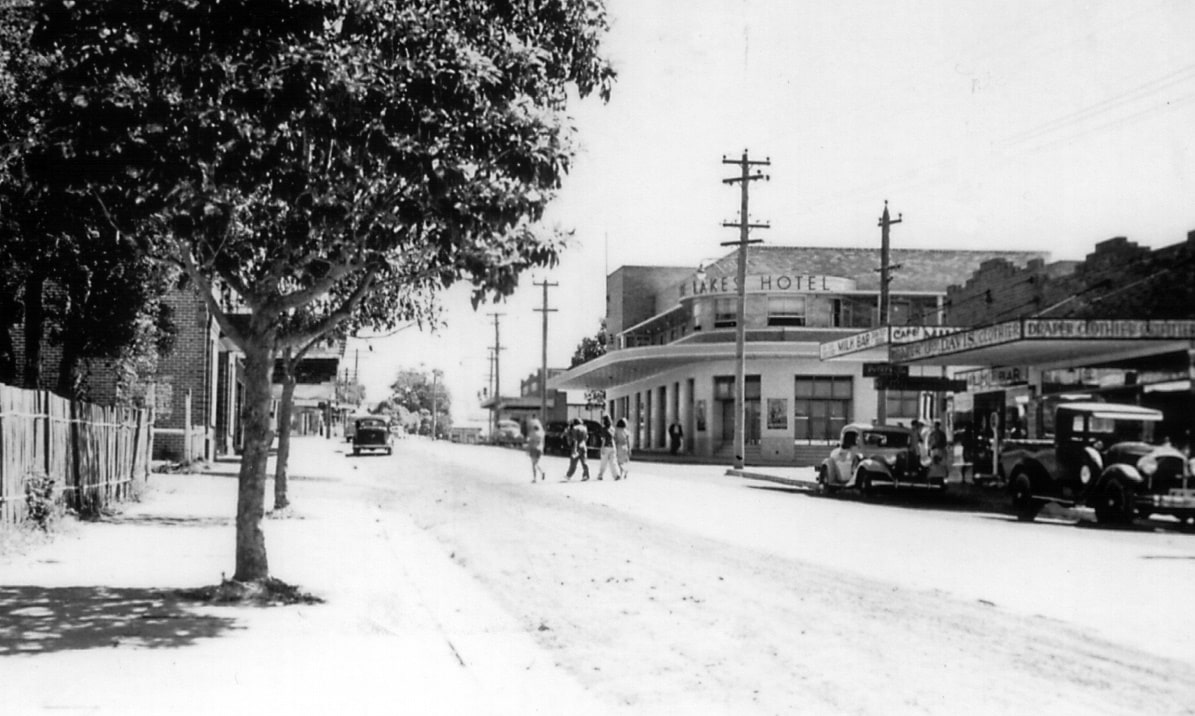
Tuggerah Lakes District Band
Now performing as the Tuggerah Lakes Showband, the Tuggerah Lakes District Band is seen here preparing to leave The Entrance on the 6th of September 1947.
They were bound for their first band contest at the city of Newcastle’s 150th Anniversary.
The drum Major was Barry (Tiny) Viney.
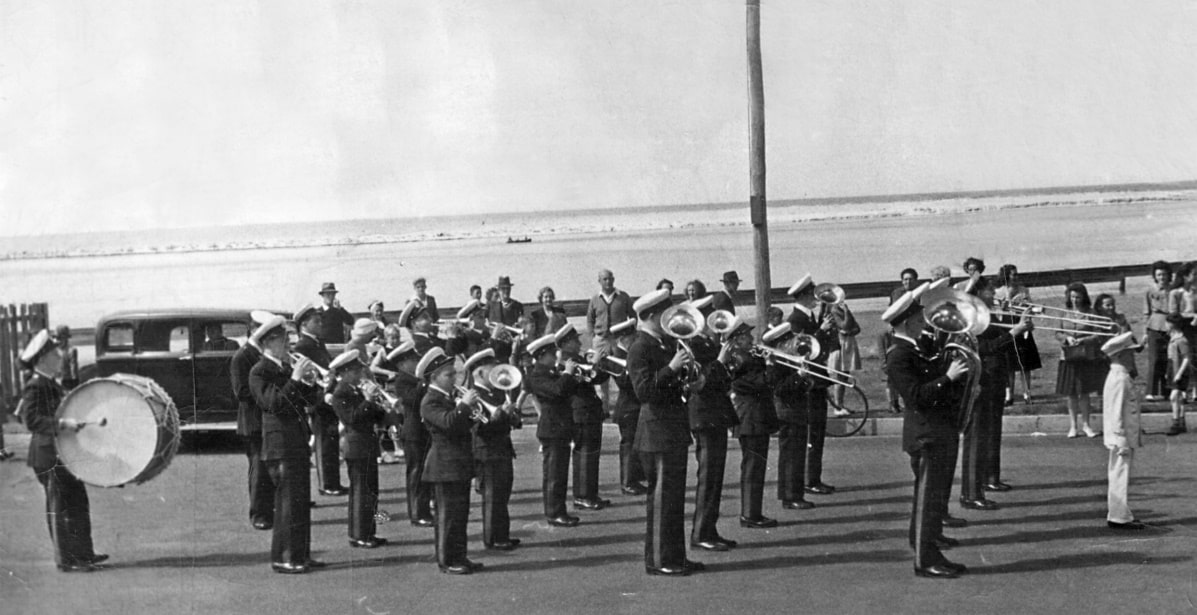
Floods Of 1949 At The Entrance
In 1949, the weather produced very strong southerly winds for 2 weeks.
It was estimated that 200,000 cubic yards of sand was washed in from the sea.
Then torrential rains came and the flood levels were 7 feet above the normal level of the lake. All areas around the lake were seriously flooded.
The photograph shows the sanitary truck in the foreground of the old wooden bridge.
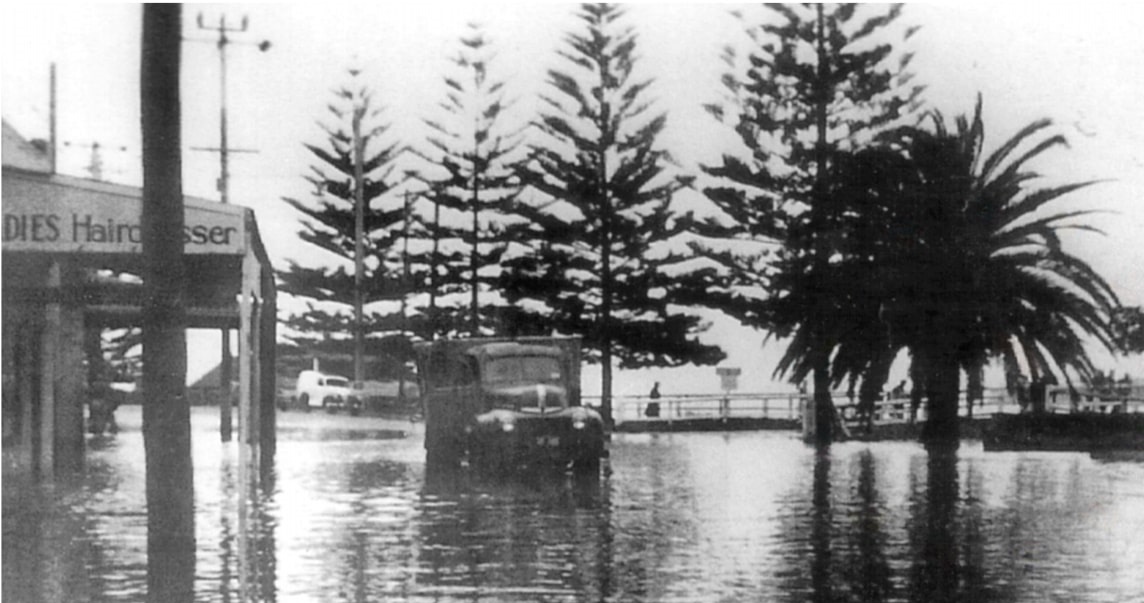
Seargent’s Bus Depot
Henry (Harry) Seargent and his two sons Wesley and Allan came to The Entrance in September 1935. The family purchased Carlyon’s Pioneer Bus Service and renamed it Seargent’s Blue Bus Line. It operated from 112 The Entrance Road and ran between The Entrance and Wyong.
When they began operations, the Seargent’s owned 5 buses and by the 1940’s the service expanded covering many more suburbs around Tuggerah Lake.
It seems the company had several names which included Seargent’s Blue Bus Lines, Seargent’s Tuggerah Lakes Bus Lines, Seargent’s Blue and White Bus Lines and Seargent’s Transit Company.

Bartons Carnival
Located approximately between 183 and 191 The Entrance Road, Barton’s Circus and Barton’s Follies were a part of the history of The Entrance.
Frank and Matilda Barton owned the circus, while their sons Lindsay and Roy became well known local identities. With the onset of WWII, Lindsay joined the Tivoli Circuit which is where he met his wife Cherrie, a wardrobe mistress.
The world of entertainment was the Barton’s life, so it was no surprise when Lindsay set up a children’s carnival on the main street of The Entrance.
Later they built an indoor carnival on the site adjacent to the Catholic Housie. It featured a range of amusements including mini golf, laughing clowns, hoop la and children’s rides.
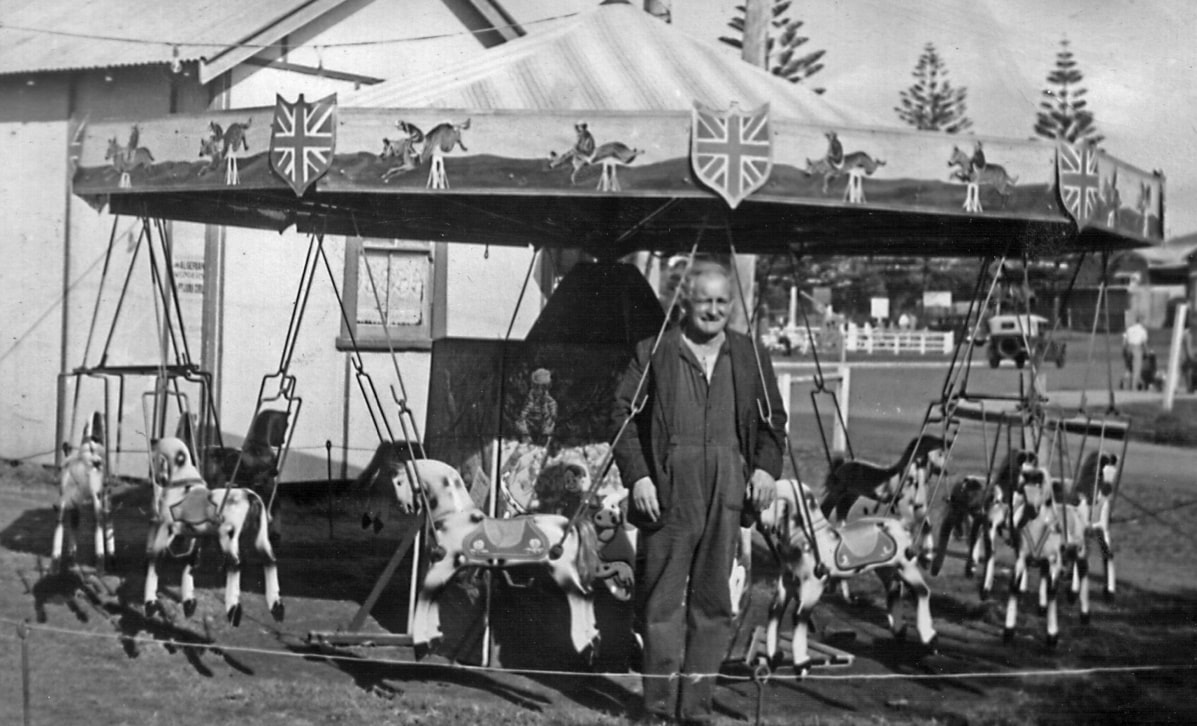
The Entrance Wooden Bridge
Officially opened on the 15th of December 1934 by the Minister for Labour and Industry Mr J.M. Dunningham. It was constructed with timber beams on 39 piers. The bridge was 365 metres long, 3 metres wide with 2 vehicular bipasses 5.5 metres wide.
The timber was cut by local tradesman from Tumbi Umbi, and the contractor was Gosford builders Beattie and Frost and the cost was $6,000.
By the late 1950’s the wooden bridge was showing a great deal of wear from the ever increasing traffic, and was demolished in 1969 by Berkeley Vale contractor John Lee.
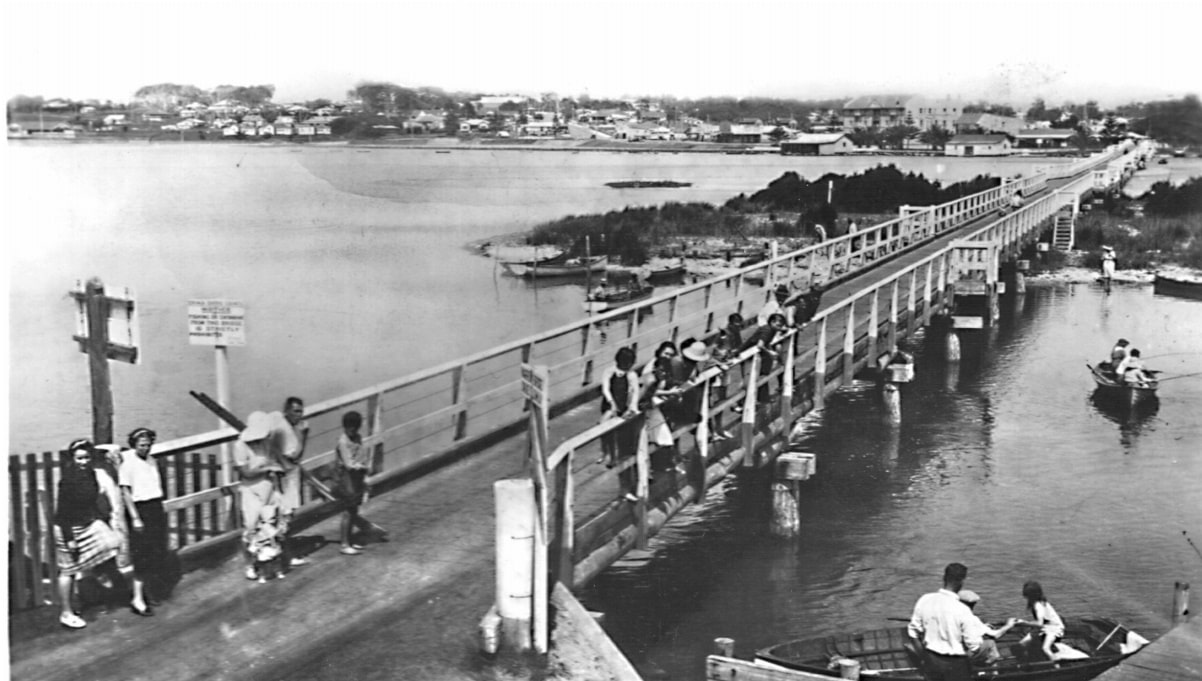
The Entrance Amateur Swimming Club
Club members photographed at The Entrance Baths circa 1950
Far right is the founder of the swimming club, Mr Fred Lewis.

Bus In Freak Crash
In the mid 1950’s, this Red Bus crashed through the wooden retaing wall and fence into the lake on the approach to the old wooden bridge.
The front wheels of the bus landed in the water, with the nose of the bus resting on a small rowing boat.
Bystanders smashed the windows of the bus to assist the passenger to safety as the bus straddled the wall.
Nobody was injured and a PMG truck was used to haul the bus back on to the road.
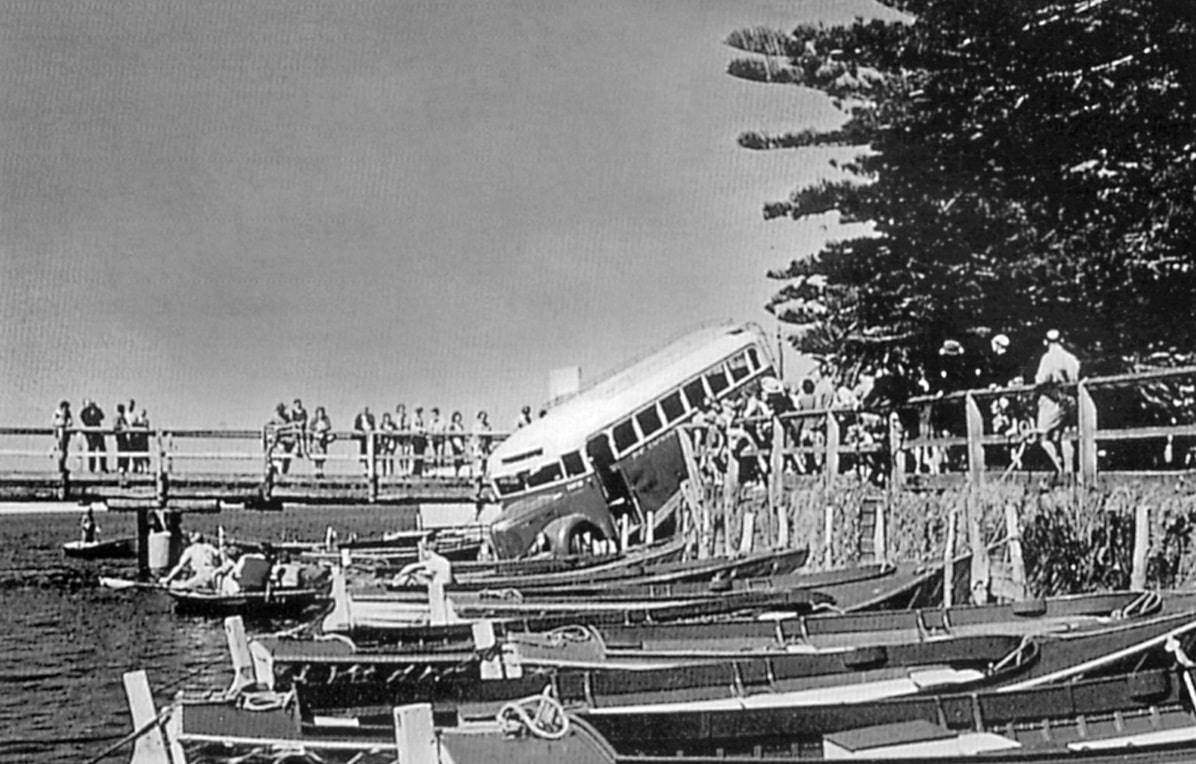
Catholic School Housie
Located at 40 – 48 The Entrance Road, The Entrance.
The first Catholic carnival was held early January 1932.
Introduced by Father O’Flaherty, the carnival was operated by Fred and Fanny Smith with the assistance of many parishoners.
Housie tickets cost 3 pence and 6 pence.
Corn was used to mark the numbers as they were called.
An array of prizes was on offer, eg kitchen items, clocks, china, chocolates and ornaments.
The carnival remained on that site for 10 years and was relocated to the Baview Guesthouse land in 1942. The carnival was then shifted to the site on The Entrance Road, near where the Commonwealth Bank now stands.
The land was purchased by the Catholic Church from Mrs Adella Dening (daughter of Richard and Gertrude Taylor) at a reduced cost as a donation to the church.
In 1958 Reverend Father Reynolds decided that a permanent hall should be built to accommodate the carnival. It was renamed the Catholic School Recreation Centre.
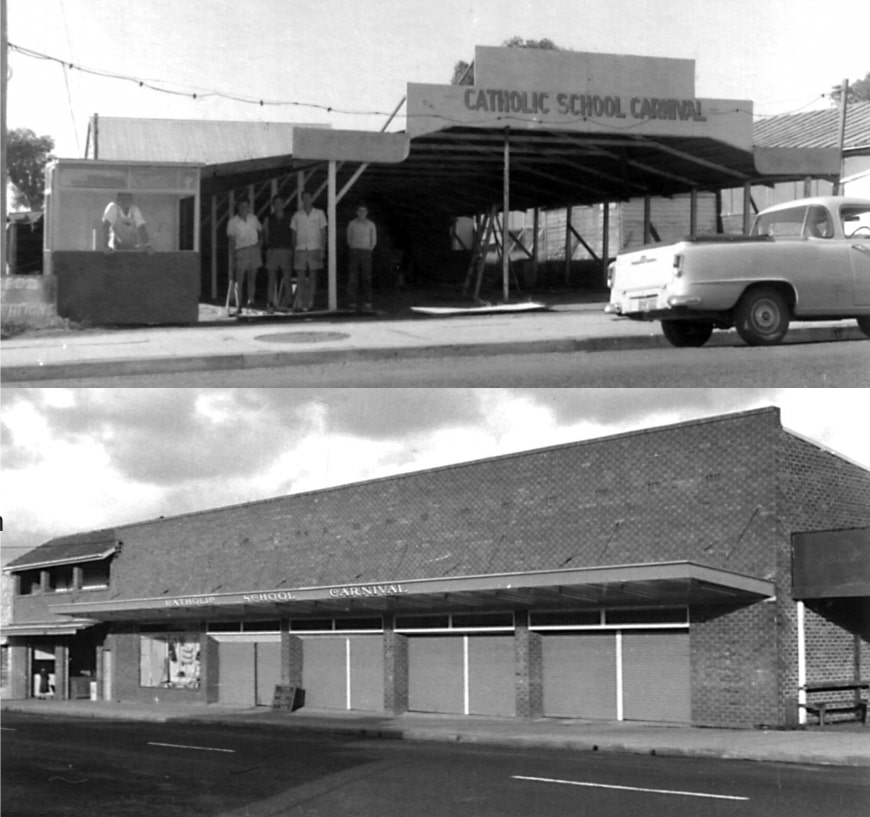
Relocating The Old Presbytery
Father Brennan purchased the cottage known as St Ives which was located next door to the Catholic Church in 1974.
He finally moved into the Presbytery in March 1948, after having lived at The Lakes Hotel, with a good Catholic family. He paid his own rent to the hotel.
The Presbytery was relocated to 29 Norfolk Avenue to allow for the construction of the current Presbytery.

Old Rotunda
The Band Rotunda was located on the Memorial Park at The Entrance.
It was dedicated to ex-councillor A.C.L. (Les) Taylor, the only person to hold office as President of both Erina and Wyong Shire Councils.
Les retired from office in 1956 and died in 1957.
It was later demolished to make way for a more passive recreation space.

The Entrance Mardi Gras
This photo taken in 1956 shows the Red Bus Company’s entry in the procession.
The driver was Alan “Fatty” Dyer.
The Mardi Gras is one of the longest running annual festivals in NSW and it was first held in 1952.
It is held each year on the first full weekend in December and the program includes a spectacular community procession.
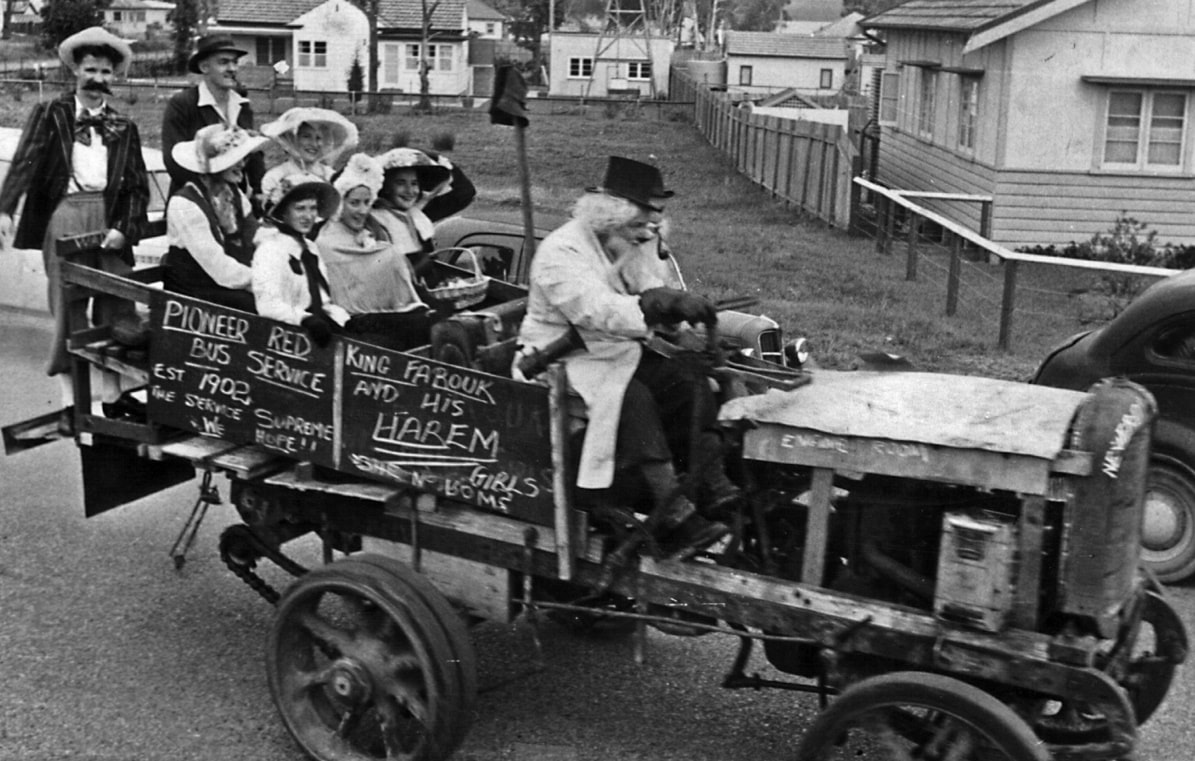
Memorial Park Circa 1960
This was the lake edge of The Entrance Channel around 1960.
This photograph shows the boardwalk area prior to the installation of the sea wall, which allowed for the creation of Memorial Park.


